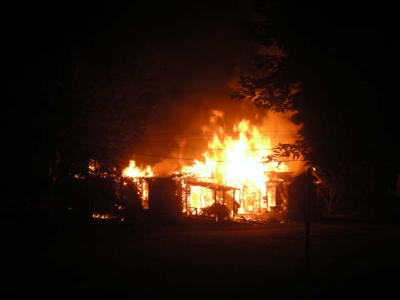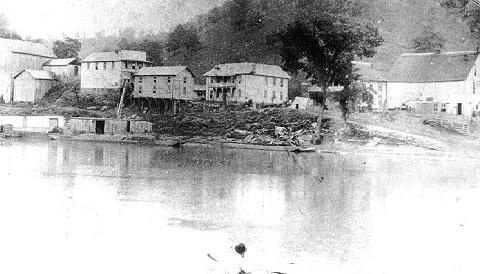THE GREAT CRESTON FIRES - Five Died In 1917 Blaze, Historic Creston Store Destroyed By Arsonist 2008

Creston's last historic structure was destroyed by
an arsonist in September, 2008 (Photo by Anna Reno)
By Bob Weaver 2008
The destruction by arson of Creston's almost last historic structure a few days ago, the Creston General Store, brought attention to two earlier fires that played havoc on the village.
See OLD CRESTON STORE DESTROYED IN ROARING FIRE
The first fire happened on April 29, 1897, destroying four buildings, including Richardson's store, "the largest in the Kanawha Valley," Squire Hopkins office, William Devore's store and a home owned by George Coffman.
An even more destructive fire swept through Creston in 1917, killing at least five people and leveling most of the business district.
It was the beginning of the end for the small town, a commercial crossroads where the West Fork of the Little Kanawha empties into the greater river.
The dead included Lindsey Stevens, Carl Stevens, Mrs. H. Merrill and two others staying in the hotel, their charred skeletons found on the bed springs of the Stevens Hotel.
The riverboat town, sometimes visited by large-stacked steamboats, was a stopping place for dozens of paddle-wheeled packet boats making their journey from the great Ohio, up the river to Grantsville and Glenville and beyond.
The river was made navigable by several locks and dams. Road travel was extremely difficult.

Creston Prior to 1917 Fire
Photo Courtesy of Seaward Lynch
The 1917 fire destroyed nearly all the buildings and homes on the east side of the West Fork.
High winds fanned the flames, causing people to run for their lives. Many of those who received burns ran into the river.
Property loss was estimated at $40,000. The house and store of J. P. Campbell, Guy Rader's Hardware and Funeral Parlor, The Stevens Hotel, The Armstrong Hotel, Eustace Gibson's store and post office, the J. E. Stump residence, the "Fuzzy" Reed residence, Harley Smith's confectionery, John Rader's Hotel and Livery Barn owned by H.C. Depue, and a log cabin said to be the first home in Creston, all destroyed.
In 1970, Leisa Grewell of Parkersburg, wrote about the recollections of her grandmother Mabel (Davis) Park.
"My Grandmother has lived in and around Creston all her life and remembers the fire well. Carl and Lindsay Stevens were staying with their sister while their parents were gone. Carl got mad at his sister and went upstairs and turned up an open gas light,which caught the curtains on fire," she wrote.
"Carl and Lindsay could not escape the fire and were burned up.. Mrs Mary Merrill and her two children were were staying in the Stevens Hotel when the fire broke out. She was staying on the second floor and she threw her two children out the window to two men who were standing below. She could not get out in time and was the third victim to perish in that fire," she recalled.
Carl Stevens was the son of Capt. and Mrs. Henry Stevens, who operated the hotel.
The two other victims, Lindsay Stevens and Mrs. Merrill, were badly burned aiding other victims to escape. They died the next morning while being taken by boat to Parkersburg.
Ms. Merrill, formerly a Isenaugle of Creston, had been working in the hotel during the absence of Mrs. Stevens, mother of the dead boys, who was at a Parkersburg hospital at the bedside of her husband who was receiving surgery.
Misses Maggie and Minnie Stevens, sisters to the dead boys, sustained severe burns while trying to help a crippled brother, both being taken down river to the hospital. Maggie reportedly lost her eyesight.
Sources at the scene contend there may have been other victims in the buildings. Travelers who stayed in Creston that night told a gruesome story, with the "screams and sufferings of the crazed victims...indescribable."
A Grantsville man, Carl Johnson, rescued a baby from the arms of Mrs. Merrill. Here is his account:
"He (Johnson) arrived in Creston returning from Parkersburg and reached Creston about 9 p.m. Monday. Retiring to bed some time afterward, in the Armstrong Hotel, he had not yet fallen asleep when a woman's screams brought him to his feet. "
"His room was in the corner of the building next to the Steven's Hotel, and on looking out the window was horrified to see the building ablaze. Hastily dressing he rushed over to the other hotel where he saw Mrs. Merrill in an upper story with her baby in her arms, frantically crying for help."
"Mr. Johnson shouted for her to throw the baby to him. He caught the child which was uninjured save for a few slight burns, carrying it across the street out of immediate danger."
"The town was turned into a raging furnace by a violent wind...We saved all the livestock in the barns and all the automobiles and then fled to the hills," reported Johnson.
In 2008, not unlike most village towns in rural West Virginia, Creston is only a memory of its former self.
Note: There are numerous photos of Creston and riverboat life to be found on the Herald.